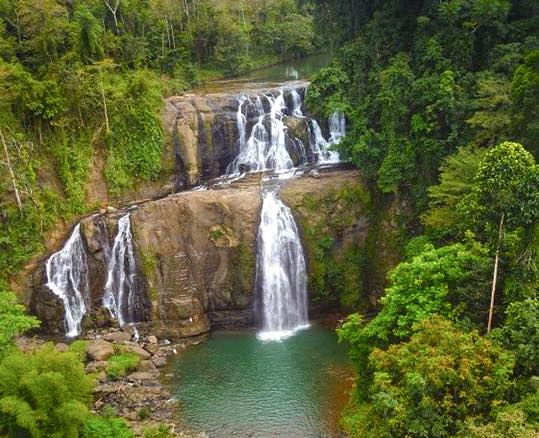Sindangan is known for having some old churches, with the most popular being the Saint Joseph the Worker church, which became a parish in 1935 under the Archdiocese of Zamboanga. Its first church building was constructed at Saint Joseph College before it was moved to its current location.
When it comes to cuisine, Sindangan is known for its delicious seafood, with the local specialty being kinilaw. Kinilaw is a dish made from raw fish fillets soaked in a subtle sour sauce, typically coconut vinegar, creating a delectable and refreshing taste.
Throughout its history, Sindangan has evolved into a thriving municipality, attracting people from different regions who contribute to its growth and development. With its captivating history, natural wonders, and warm hospitality, Sindangan continues to charm both locals and visitors alike.
The People of Sindangan celebrate several festivals all year round, and one of them is the Saint Joseph the Worker Town Fiesta, which happens on the first day of May each year. During the event, the townspeople honor Saint Joseph the Worker, who is their primary patron saint, serving as a role model for all fathers and laborers. He is considered fit as such, considering that the people of Sindangan are known as hard workers since the time before World War II.
Another event to watch here is Siari’s Fiest Day, which happens every 3rd Sunday of January to honor Sto. Nino de Cebu, where there is a grand fluvial procession on the eve of the feast. During the culmination of the event, there will be a procession of street dancers who compete for a certain prize. Other festivals are the Pasidungog Festival and the Linggo ng Sindangan, which is the municipality’s charter day that is observed from December 17 to 22.
As for the food here, it is said that Sindangan people offer the best seafood that will rock your appetite. One of the popular meals here is the kinilaw, which is prepared with raw fish fillets that are tender-soaked in the subtle sour sauce or the local coconut vinegar, making it so delicious. While there are different versions of kinilaw in the Philippines, you might find the one in this municipality the best of them all.
History of Sindangan – This town sets back its origin during the pre-Spanish colonization of the Philippines. Subanon people or tribe was its first inhabitants. The Subanens, a nomadic tribe of Indo-Malayan stock, were the earliest known settlers who lived along river banks or “suba”, from which word they received their present tribal identity as Subanen. They built houses and sanctuaries for their shelter and formed their own ‘government’ ruled by the Datu.
Over the years the Moros settled also in this place and preached the Islam religion.
During the Spanish reign in the archipelago where towns had already been established, Sindangan became a part of the jurisdiction of then the municipality of Dapitan as early as 1598 to 1729 and slowly people from the Visayas islands flocked to Mindanao to find greener pasture.
Christianity was also propagated in this area through the effort of those Catholic missionaries like the Society of Jesus or the Jesuits, the Augustinians, and the Dominicans. One of its great missionaries was Padre Francesco Palliola, a Jesuit missionary from Nola, Italy who tirelessly preached the Christian message, perform baptisms and sacraments, and helped the tribal people in this area of Zamboanga Peninsula.
He was assigned to Dapitan and Katipunan and met his martyrdom in the barrio of Ponot now Jose Dalman where he was killed by the Subanen people through the leadership of their chieftain. Later on, Sindangan became part of a far town Lubungan now Katipunan in the 19th Century.
Sindangan Municipality
On December 23, 1936, by virtue of Executive Order No. 77 issued by President of the Commonwealth of the Philippines, Manuel L. Quezon, the municipalities of Sindangan, Siocon, Margosatubig, Pagadian, and Kabasalan was created out of the municipal districts of Sindangan, Panganuran, Labangan, Dinas, Sibuko, Sirawai, Margosatubig, Malangas, Kabasalan, and Bangaan. The Municipality of Sindangan covered the area of Sindangan and Panganuran.
Bartolome Lira Sr. was appointed to organize the Municipality of Sindangan and was its first Municipal President. As his appointive tenure expired, he was elected as the first Municipal Mayor of Sindangan until 1941.
In 1955, four barrios were created: Dicoyong – sitios of Labakid, Layawan, Morob, Gusani, Domalogdog, Maoal,Nato, Diongan, Makasing, Dipolo and Dicoyong Proper; Bacungan – sitios of Palandok, Rison, Bogabongan, Manil, Gusao, Talinga and Bacungan Proper; Lagag – sitios of Milaub, Mangalop, Gopit, Pase, Lipaga, Mianib, Siayan, Litolit, Balok, and Lagag Proper; and Bitoon – sitios of Misok, Hagonoy, Lico, Guban, Makinong, and Bitoon Proper
Binuangan- sitios of Taguicon, Upper Binuangan, and Gusapong Proper. In 1959, the sitios of Gonayen, Gowayan, Domogok, Dinoyak, Mangilay, Pange, Balak, Laclac, Siriac, Macasing and Diongan were constituted into the barrio of Gonayen.
Since its elevation to a municipality in 1936, people from Luzon and Visayas continued migrating to Sindangan to settle together with their families and built businesses. That is why aside from the Subanens, there are Sindanganons whose origins are from Bohol, Cebu, Samar, Leyte, Negros, Bicol, Pampanga, and Manila.


